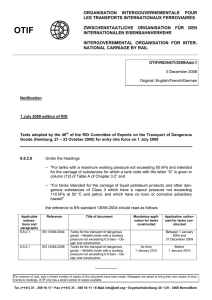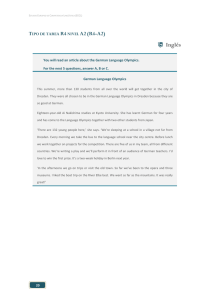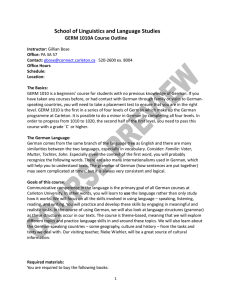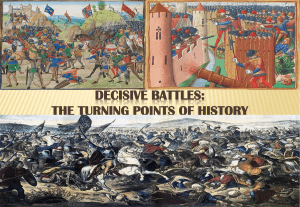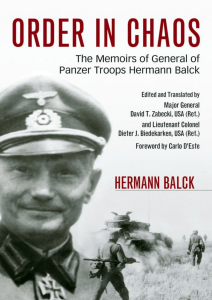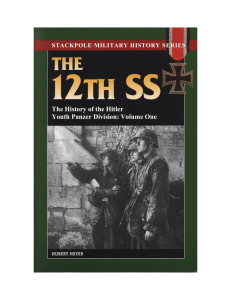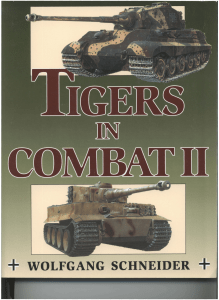(84th Army Corps), General Erich Marcks, wanted
Anuncio
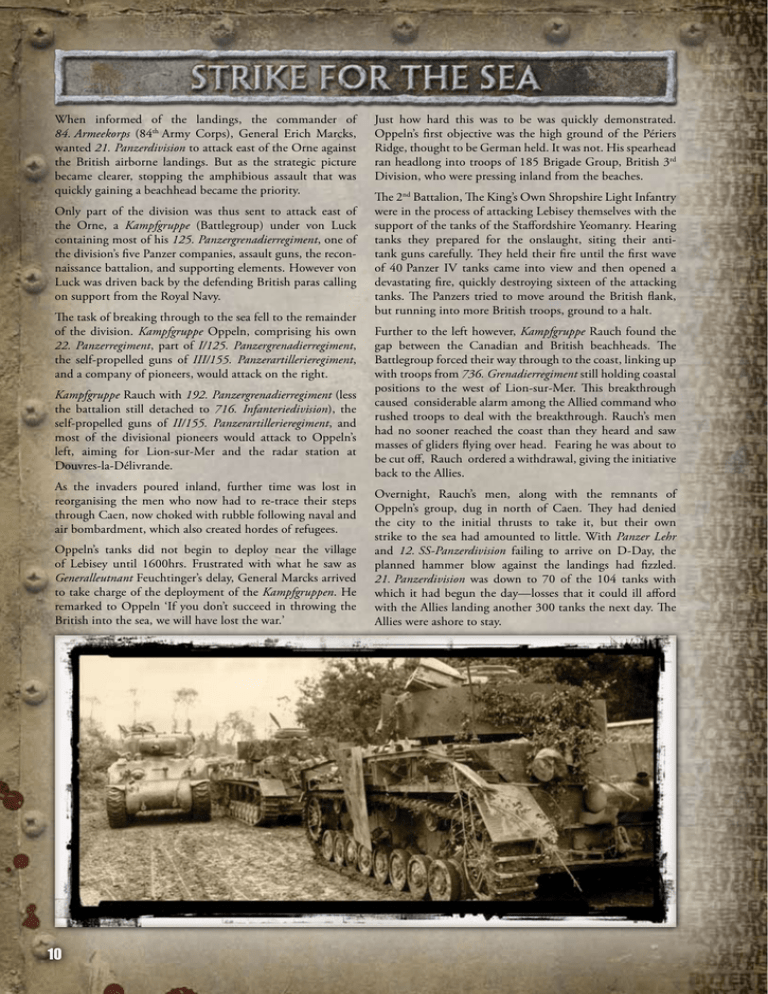
When informed of the landings, the commander of 84. Armeekorps (84th Army Corps), General Erich Marcks, wanted 21. Panzerdivision to attack east of the Orne against the British airborne landings. But as the strategic picture became clearer, stopping the amphibious assault that was quickly gaining a beachhead became the priority. Only part of the division was thus sent to attack east of the Orne, a Kampfgruppe (Battlegroup) under von Luck containing most of his 125. Panzer­grenadier­regiment, one of the division’s five Panzer companies, assault guns, the reconnaissance battalion, and supporting elements. However von Luck was driven back by the defending British paras calling on support from the Royal Navy. The task of breaking through to the sea fell to the remainder of the division. Kampfgruppe Oppeln, comprising his own 22. Panzerregiment, part of I/125. Panzergrenadierregiment, the self-propelled guns of III/155. Panzerartillerieregiment, and a company of pioneers, would attack on the right. Kampfgruppe Rauch with 192. Panzergrenadierregiment (less the battalion still detached to 716. Infanteriedivision), the self-propelled guns of II/155. Panzerartillerieregiment, and most of the divisional pioneers would attack to Oppeln’s left, aiming for Lion-sur-Mer and the radar station at Douvres-la-Délivrande. As the invaders poured inland, further time was lost in reorganising the men who now had to re-trace their steps through Caen, now choked with rubble following naval and air bombardment, which also created hordes of refugees. Oppeln’s tanks did not begin to deploy near the village of Lebisey until 1600hrs. Frustrated with what he saw as Generalleutnant Feuchtinger’s delay, General Marcks arrived to take charge of the deployment of the Kampfgruppen. He remarked to Oppeln ‘If you don’t succeed in throwing the British into the sea, we will have lost the war.’ 10 Just how hard this was to be was quickly demonstrated. Oppeln’s first objective was the high ground of the Périers Ridge, thought to be German held. It was not. His spearhead ran headlong into troops of 185 Brigade Group, British 3rd Division, who were pressing inland from the beaches. The 2nd Battalion, The King’s Own Shropshire Light Infantry were in the process of attacking Lebisey themselves with the support of the tanks of the Staffordshire Yeomanry. Hearing tanks they prepared for the onslaught, siting their antitank guns carefully. They held their fire until the first wave of 40 Panzer IV tanks came into view and then opened a devastating fire, quickly destroying sixteen of the attacking tanks. The Panzers tried to move around the British flank, but running into more British troops, ground to a halt. Further to the left however, Kampfgruppe Rauch found the gap between the Canadian and British beachheads. The Battlegroup forced their way through to the coast, linking up with troops from 736. Grenadierregiment still holding coastal positions to the west of Lion-sur-Mer. This breakthrough caused considerable alarm among the Allied command who rushed troops to deal with the breakthrough. Rauch’s men had no sooner reached the coast than they heard and saw masses of gliders flying over head. Fearing he was about to be cut off, Rauch ordered a withdrawal, giving the initiative back to the Allies. Overnight, Rauch’s men, along with the remnants of Oppeln’s group, dug in north of Caen. They had denied the city to the initial thrusts to take it, but their own strike to the sea had amounted to little. With Panzer Lehr and 12. SS-Panzerdivision failing to arrive on D-Day, the planned hammer blow against the landings had fizzled. 21. Panzerdivision was down to 70 of the 104 tanks with which it had begun the day—losses that it could ill afford with the Allies landing another 300 tanks the next day. The Allies were ashore to stay. Kampfgruppe Oppeln Attacks As the afternoon of D-Day wears on, the British forces are nearing Caen. One last village stands in their way. As they launch their assault, the German counterattack begins. The Kampfgruppe Oppeln Attacks scenario uses the Airborne at Dusk, Ambush, Delayed Reserves, Mobile Battle, Reserves, and Scattered Reserves special rules. Your orders Ending the Battle The battle ends when: • Either player starts their turn in possession of one of their objectives, or • Dusk falls under the Airborne at Dusk special rule, and both sides break off the battle. Deciding Who Won German The Allies have landed. High command has finally released you to counterattack and push them back into the sea. You must punch through the leading British troops and breakthrough to the beaches. If either player holds one of their objectives, they win the battle. Otherwise the outcome is inconclusive as both sides retire for the few hours of darkness before making another effort in the morning. Airborne at Dusk British Progress toward Caen was going well. Until your lead companies bumped into dozens of counterattacking German tanks. You must hold your gains and push on to Lebisey Wood, ready to push into Caen tomorrow. Preparing for battle 1. Set up the terrain as shown on page 13. Place the objectives at the indicated points. The table is 4’/120cm by 6’/180cm. 2. The German player places their starting troops at the indicated points. The remainder of their force is held in Reserve. 3. The British player places their starting troops at the indicated points. 5 (Anti-tank) Platoon and 41 Battery are held off the table in Ambush. The remainder of the force is in Delayed and Scattered Reserve. Beginning the Battle 1. The British player has the first turn. 2. This is a mobile battle, so for the British player’s first turn of the game all teams (including those deploying from ambush) are considered to be moving. As dusk fell hundreds of gliders flew over the battlefield, reinforcing the 6th Airborne Division. Fearing being cut off, General Feuchtinger ordered the Panzers to break off. At the start of the British player’s turn 7, after taking a Company Morale Check if necessary, the British player rolls a die. On a roll of 5+, dusk falls and the game ends. Otherwise, the German player rolls two dice in their turn, also needing a 5+ on either die to end the game. Each player continues to roll in turn, adding one die each time, until they roll a 5+ and the game ends. D-Day Mini Campaign Kampfgruppe Oppeln Attacks can be played as part of a mini campaign along with the Kampfgruppe Rauch Attacks scenario on page 14. The winner of the Kampfgruppe Rauch Attacks scenario wins the campaign. However, your chances of winning that battle will be greatly enhanced or reduced by your performance in this battle. Other places, Other Times As it turned out, the only significant armoured force to launch a counterattack on D-Day was Kampfgruppe Oppeln of 21. Panzerdivision. Scattered German tank units did counterattack against the Americans on Utah Beach, but never in more than platoon strength. You could fight this battle with a US Rifle Company, or even better an Assault Company from Bloody Omaha, taking the part of the British. Replace both Armoured Platoons with a single Tank Platoon of three M4 Sherman tanks and the M10 self-propelled guns with towed 3” guns. To make the game interesting, you could give the Germans all of the tanks available to oppose the landings on Utah Beach. Equip the German counterattack force with obsolete French tanks being used for training. So, instead of Panzer IV tanks, the German Panzer Platoons have Panzer 39H(f ) Hotchkiss tanks (you could use the Italian R.35 model for these) with a Panzer III tank as the command vehicle. The Germans debated moving their 12. SS-Panzerdivision into a position opposite Omaha Beach. You could also play the scenario with the same American force facing off against a counterattack by fearless SS-Panzer Platoons equipped with Panzer IV tanks. Moving further afield, the Red Army conducted many river crossing operations. These often faced German counterattacks trying to push them back to the river line. You could play the scenario with a Soviet Strelkovy Batalon in place of the British force. 11 German Kampfgruppe Oppeln Oberst Hermann von Oppeln-Bronikowski was a cavalryman since before the First World War, although he won his Iron Cross fighting as an infantryman in that war. His service in Poland, France and Russia won him a second Iron Cross and a Knight’s Cross. After being wounded at Kursk, he took command of 22. Panzerregiment. On D-Day he was given 22. Panzerregiment Oberst von Oppeln-Bronikowski 5. Panzerkompanie 1./125. Panzergrenadierregiment Verstärkungen the task of striking for the beaches with the only Panzer force available to intervene. With his 4. Kompanie fighting parachutists across the Orne and 1. Kompanie delayed, it was the composite 5. Kompanie from II Panzerabteilung that led the way. The remainder of the regiment followed as quickly as it could, pushing towards Lion-sur-Mer on the beach. Panzerkompanie (Confident Veteran) Company HQ (with two Panzer IV H tanks at ) Panzer Platoon (with five Panzer IV tanks at ) Panzergrenadier Platoon (at full strength, with no Panzerfaust anti-tank launchers and no trucks, at ) Reserves 2. Panzerkompanie Panzer Platoon (with five Panzer IV tanks) 3. Panzerkompanie Panzer Platoon (with five Panzer IV tanks) III/155. Panzerartillerieregiment Armoured Artillery Battery (with six 10.5cm (Sf ) Lorraine Schlepper self-propelled guns) British 185 Brigade Group Lieutenant Colonel Maurice’s Kings Own Shropshire Light Infantry led the push by 3rd Division’s 185 Brigade to Caen on the afternoon of D-Day. After taking Beuville and Bieville, W and Y Companies (the KSLI used W, X, Y, and Z rather than the more usual A, B, C, and D for their companies) set out for Lebisey. This village was reported to 2nd Battalion, Kings Own Shropshire Light infantry Lieutenant Colonel Maurice Company HQ (with Universal Carrier) Rifle Platoon (at full strength at ) X Company Rifle Platoon (at full strength at ) Y Company Rifle Platoon (at full strength at ) Flank Guard 5 (Anti-tank) Platoon 41 Anti-tank Battery (SP), 20 Anti-tank Regiment th Armoured Platoon (rated Confident Veteran with three Sherman III tanks and one Firefly VC tank at ) Ambush Anti-tank Platoon (with four 6 pdr guns) Anti-tank Battery (SP), Royal Artillery (with two M10 (3”) SP) Reserves Delayed and Scattered Reserves Z Company Rifle Platoon (at full strength) A Squadron, Staffordshire Yeomanry 7 Field Regiment, Royal Artillery 12 Rifle Company (Confident Trained) W Company C Squadron, Staffordshire Yeomanry th be lightly held, however the Panzergrenadiers of 125. Panzer­ grenadierregiment had just arrived there prior to their own attack. After halting at a tank obstacle, the Shropshires were preparing for another attack just as the first German tanks appeared over the ridge. Their tanks and anti-tank guns destroyed the leading German tanks as more approached. Armoured Platoon (as above) Field Battery (SP), Royal Artillery (with eight Priest selfpropelled guns) Terrain The terrain behind Sword Beach is open fields. There are no fences or hedges to break up the wide open spaces. Even the crops are still young, barely knee high, giving no cover. The low ridges are tall enough to hide a tank, with gentle slopes that provide no obstacle to movement. However, the wooded stream between Bieville and Lebisey has been transformed into a tank obstacle for German training exercises. It is rated as Very Difficult Going. German Objective Périers-sur-le-Dan The villages of Beuville, Bieville and Lebisey are set amongst orchards and woods and bounded by Bocage hedgerows. The hedgerows are tall, far too tall to be seen over from the ridges, and gave the villages the appearance of woods from a distance. The roads were wider than in the western part of Normandy and allow vehicles to manoeuvre normally and pass other vehicles if need be. Beuville British Deployment Area Le Landel Bocage Hedgerows All hedgerows on the table are Bocage hedgerows. These are taller than a tank, Very Difficult Going, and provide Bulletproof Cover to troops sheltering behind them. Teams must start adjacent to a Bocage hedgerow to cross it. The full Bocage rules are provided in more detail in the D-Day book or at our web page, www.FlamesOfWar.com. N To Sword Beach German Objective Bieville Anti-tank ditch Lebisey British Objective British Objective German Reserves Arrive here To Caen 13 Kampfgruppe Rauch Attacks Soon after the tanks of Kampfgruppe Oppeln attacked, the Panzergrenadiere of Kampfgruppe Rauch launched their own attack on their western flank. Finding the gap between the British and Canadian beaches, they reached the radar station at Douvres-la-Délivrande before encountering opposition. The Kampfgruppe Rauch Attacks scenario uses the Airborne at Dusk (see page 11), Reserves, and Mobile Battle special rules. 2. The Canadian player places their starting troops in their deployment area. The remainder of their force remains in Reserve. These will arrive between Tailleville and Beny-sur-Mer. 3. The German player places their troops in the indicated areas. Beginning the Battle 1. The Canadian player has the first turn. Your orders 2. This is a mobile battle, so for the Canadian player’s first turn of the game all teams are considered to be moving. German You must reach the sea at Lion-sur-Mer, splitting the Allied invasion force in two. The division will then turn and thrust along the beaches pushing the invaders back into the sea. Canadian You have made it ashore with surprisingly light casualties. Progress inland has been delayed by massive traffic jams on the beaches and sporadic German opposition. You must strike inland towards Caen, clearing the strongpoint at Douvres-la-Délivrande on the way. Preparing for battle 1. Set up the terrain as shown on page 15. Place the objectives at the indicated points. The table is 4’/120cm by 6’/180cm. Ending the Battle The battle ends when dusk falls under the Airborne at Dusk special rule, and both sides break off the battle. Deciding Who Won The German player gets one victory point for holding the Douvres-la-Délivrande radar station objective and two victory points for holding the Lion-sur-Mer objective. The Canadian player gets one victory point for holding the Douvres-la-Délivrande radar station objective and one victory point each for holding the Colomby-sur-Thaon and Cazelle objectives. The player holding the most victory points at the end of the game wins. D-Day Mini Campaign Kampfgruppe Rauch Attacks can be played as part of a mini campaign along with the Kampfgruppe Oppeln Attacks scenario on page 13. Play the Kampfgruppe Oppeln Attacks scenario first, then this scenario. The winner of the Kampfgruppe Rauch Attacks scenario wins the campaign. If the German player won the Kampfgruppe Oppeln Attacks scenario, the victorious tanks of Kampfgruppe Oppeln arrive to assist Kampfgruppe Rauch. The German player receives a Panzer Platoon with three Panzer IV tanks as a Delayed Reserve arriving at the edge of the German deployment area behind Douvres-la-Délivrande in this scenario. If the British won the Kampfgruppe Oppeln Attacks scenario, the attack by Kampfgruppe Rauch is delayed and the German forces that would normally start in Douvres-la-Délivrande in area start at Cazelle in area instead. Other places, Other Times Like the Kampfgruppe Oppeln Attacks scenario, you could easily fight this battle with other forces to represent different battles or possibilities. A perfect example would be the planned counterattack against Omaha Beach by Kampfgruppe Meyer (See Bloody Omaha for details on 352. Infanteriedivision). As it turned out they spent all day marching in the divisions rear, but things could have been very different if they had been order to counterattack the beach. Use a US Rifle Company, or even better an Assault Company from Bloody Omaha, in place of the Canadian force. Replace both Armoured Platoons with a single Tank Platoon of three M4 Sherman tanks and the M10 self-propelled guns with towed 3” guns. 14 If you have Bloody Omaha, then use that to create Kampfgruppe Meyer. Otherwise, just use a basic German motorised Panzergrenadierkompanie with a platoon of 3-4 StuG G assault guns and some towed artillery in support. The sort of confused breakthrough situation portrayed in Kampfgruppe Rauch Attacks happened many times on the Eastern Front. You could replace the Canadian force with a Soviet Motostrelkovy Batalon that has forced a river and is breaking through into the depths of the German defences with only a small ‘Hedgehog’ position between them and victory. The small German Panzergrenadier force is attempting to reach the river crossings to stem the tide. This battle takes place along a broad north-south ridge. A stream drains east cutting down the side of the ridge. In early summer the stream is shallow, barely an obstacle, and counts as Difficult Going. In the early summer the crops are low and provide little in the way of concealment, giving the defenders a wide-open field of fire, although they do provide good going for the attacking forces. Only the low bed of the railway line provides much of an obstacle, but even that is just Difficult Going and provides no concealment, although it is Bulletproof Cover for stationary Infantry and Man-packed Gun teams immediately behind it. To Juno Beach To Lion-sur-Mer Tailleville Canadian Reserves arrive here Terrain Objective Canadian Deployment Area Douvres-laDélivrande Beny-surMer Douvres-la-Délivrande The night-fighter control radar station at Douvres-la-Délivrande is well fortified. The first line of defence is a minefield. Inside that is a barbed wire entanglement. As normal, each section of defences is usually 8”/20cm long by 2”/5cm wide. The exception to this is the barbed wire entanglements where each side of the fortification is made up of a 8”/20cm and a 4”/10cm section. The garrison is well provided with Trench Lines for protection. They are protected by an HMG in an Open Bunker, a 5cm PaK38 gun in an Open Bunker, and a 2cm FlaK38 gun in an Open Bunker (see page 30 for the rules on Open Bunkers, and page 209 of the rulebook for the rules on Bunkers). German Deployment Area Basly Objective Objective Colomby-surThaon Cazelle N German Deployment Area To Caen To Caen Minefield 5cm PaK38 in Open bunker Barbed wire 2cm FlaK38 in Open bunker Trenches HMG in Open bunker 15 German Kampfgruppe Rauch Originally serving in the army between the wars, Oberst Rauch rejoined the army in 1935. After commanding Pionier and Panzergrenadier units in combat, he took over command of the newly formed 192. Panzergrenadierregiment. On D-Day his command was deployed as a reserve for 716. Infanteriedivision manning the coastal defences. 192. Panzergrenadierregiment Oberst Rauch Counterattacking with his armoured I Battalion, Kampfgruppe Rauch reached the night-fighter control station at Douvres-la-Délivrande defended by a small force from 736. Grenadierregiment and the Luftwaffe (Air Force) signals troops manning it, before pushing on to the sea at Luc-sur-Mer. Gepanzerte Panzergrenadierkompanie (Confident Veteran) Company HQ (with artillery Observer team, at ) I/192. Panzergrenadierregiment Gepanzerte Panzergrenadier Platoon (at full strength, at ) II/192. Panzergrenadierregiment Panzergrenadier Platoon (with two squads and no trucks, at ) 4/192. Panzergrenadierregiment Armoured Anti-tank Platoon (with three S304(f ) (PaK40) half-tracks, at ) II/155. Panzerartillerieregiment Armoured Artillery Battery (with three 15cm (Sf ) Lorraine Schlepper self-propelled guns, at ) 3/53. Luftwaffe Nachrichtenregiment Luftwaffe Field Platoon (rated Reluctant Trained with two squads, at ) with Gun teams in Open Bunkers as shown on the map Stab/II/736 Grenadierregiment, 716. Infanteriedivision Two independent SMG teams (rated Reluctant Trained at ) No command teams have Panzerknacker training or Panzerfaust anti-tank launchers. 8 Canadian Brigade Group 8 Canadian Brigade Group under Brigadier Blackadder landed on the eastern half of Juno Beach. By midday the North Shore Regiments reported Tailleville clear and were set to move onto their final objective—the radar station. They did not set out until 1730hrs, though, as fighting flared up repeatedly against elements of the headquarters of 8 (Eastern) Brigade Group Brigadier Ken Blackadder Rifle Company (Confident Trained) Company HQ (with Universal Carrier) The Queen’s Own Rifles of Canada Rifle Platoon (with two squads) The North Shore (New Brunswick) Regiment Rifle Platoon (with two squads) The Cameron Highlanders of Ottawa (MG) Machine-gun Platoon (with one section in MMG Carriers) 10th Armoured Regiment (The Fort Garry Horse) Armoured Platoon (with three Sherman III tanks) 3rd Anti-tank Regiment, Royal Canadian Artillery Anti-tank Battery (SP), RA (with two M10 (3”) SP) 14 Field Regiment, Royal Canadian Artillery th 9 (Highland) Brigade Group The North Nova Scotia Highlanders 27th Armoured Regiment (The Sherbrooke Fusiliers) 16 736. Grenadierregiment. The Queen’s Own Rifles supported by the Fort Garry Horse pushed inland to Beny-sur-Mer and Basley. About this time the follow-on 9 Brigade Group finally escaped the massive traffic snarl-up on the beach and moved inland towards Carpiquet airfield at Caen, with the North Novas and the tanks of the Sherbrookes in the lead. Field Battery (SP), Royal Artillery (with four Priest selfpropelled guns) Reserves Rifle Platoon (at full strength) Armoured Platoon (with three Sherman III tanks and one Firefly VC tank)
